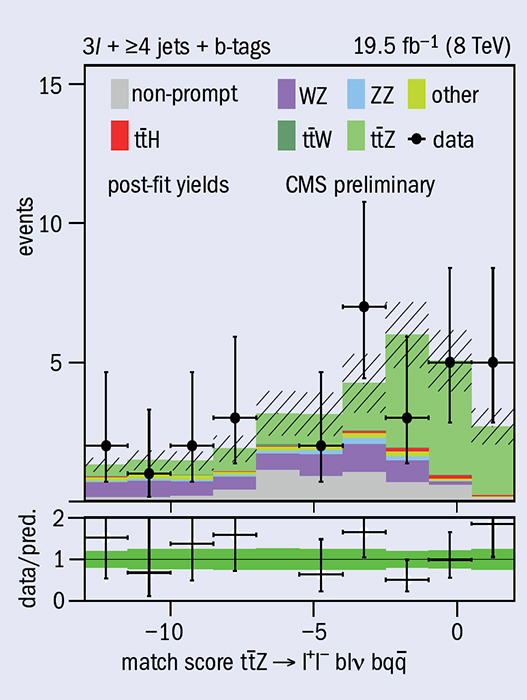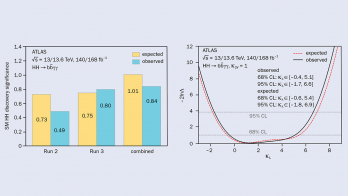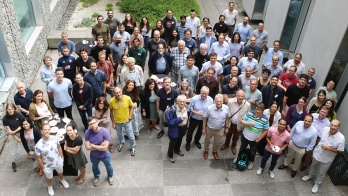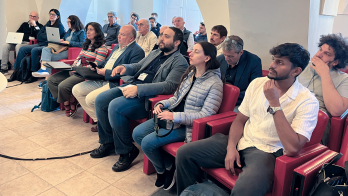In an improved analysis of 8 TeV collision events at the LHC, the CMS experiment has made the first observation of the production of a top quark–antiquark pair together with a Z boson, ttZ, as well as the most precise cross-section measurements of ttZ and ttW to date.

Since the top quark was discovered 20 years ago, its mass, width and other properties have been measured with great precision. However, only recently have experiments been able to study directly the top quark’s interactions with the electroweak bosons. Its coupling to the W boson has been tightly constrained using single top events in proton–antiproton collisions at Fermilab’s Tevatron and proton–proton collisions at the LHC. Direct measurements of the top quark’s couplings to the photon (γ) and the Z or Higgs boson are currently most feasible in LHC collisions that produce a tt pair and a coupled boson: ttγ, ttZ and ttH. However, studying these processes (and the related ttW) is challenging because their expected production rates are hundreds of times smaller than the tt- cross-section.
The CMS and ATLAS experiments at CERN have previously observed ttγ, found evidence for tttZ, and conducted searches for ttW and ttH in 7 and 8 TeV proton–proton collisions. Deviations from the predicted cross-sections could hint at non-Standard Model physics such as anomalous top-quark-boson couplings or new particles decaying into multiple charged leptons and bottom quarks.
The decays ttW and ttZ both produce two b quarks, and are most easily distinguished from tt, WZ, and ZZ backgrounds when they produce two to four charged leptons and up to four additional quarks. However, signal events can be identified even more precisely when the reconstructed leptons and quarks are matched to particular top, W or Z decays. Leptons of the same flavour and opposite charge, with an invariant mass near 91 GeV, are assigned to Z decays. The remaining leptons and quarks are compared with top and W decays using the charge and b-quark identification of single objects, together with the combined mass of multiple objects. Every possible permutation of objects matched to decays is tested, and the best matching is taken as the reconstruction of the entire ttW or ttZ event. Background events with fewer top quarks or W or Z bosons are typically worse matches to ttW and ttZ than signal events.
The figure shows the best match score in events with three charged leptons and four reconstructed quarks in data, along with estimates of ttZ, WZ and tt, as well as tt and single Z with a non-prompt lepton from quark decay. The hashed area indicates the 68% uncertainty in the signal-plus-background prediction. The matching scores are combined with quark and lepton momenta and other distinguishing variables in so-called boosted decision trees (BDTs), which separate signal from background events. The BDTs are used to compare data events with signal and background models, and so estimate the number of signal events contained in the data. This estimate makes it possible to measure the cross-sections.
The ttW cross-section is measured in events with two same-charge leptons or three leptons, and is found to be 382+117–102 fb, somewhat larger than the 203+20–22 fb predicted by the Standard Model. This higher-than-expected value is driven by an excess of signal-like data events with two same-charge leptons. The data overall exclude the zero-signal hypothesis with a significance of 4.8σ. Events with two opposite-charge leptons, three leptons, or four leptons are used in the ttZ search. The measured ttZ cross-section is 242+65–55 fb, quite close to the Standard Model prediction of 206+19–24 fb. The zero-signal hypothesis is rejected with a significance of 6.4σ, making this measurement the first observation of the ttZ process.
The measured cross-sections are also used to place the most stringent limits to date on models of new physics employing any of four different dimension-six operators, which would affect the rates of ttW or ttZ production. Further studies in 13 TeV collisions should provide an even more detailed picture of these interesting processes and may reveal the first hints of new physics at the LHC.








